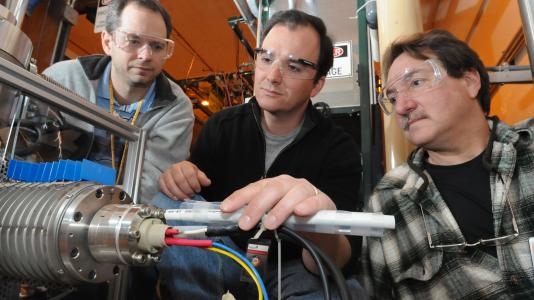
Ions stopped, reaccelerated in charge breeder for CARIBU
ARGONNE, Ill. — Scientists at the U.S. Department of Energy’s (DOE) Argonne National Laboratory have successfully stopped and then reaccelerated a stable ion through a newly constructed charge-breeder, bringing the Californium Rare Isotope Breeder Upgrade (CARIBU) project closer to completion.
“We have this elegant balancing act we play,” said senior accelerator physicist Richard Pardo. “If we go too slowly, the ions are reflected back, and if we go too fast they go right through.”
Beams of stable isotopes from elements across the entire periodic table have been used at the Argonne Tandem-Linac Accelerator System (ATLAS) for research in nuclear physics for many years.
But when additional protons or neutrons are added to originally stable isotopes, the nuclei eventually become ‘particle unstable,’ emitting excess protons or neutrons. Neutrons, unlike protons and electrons, have no charge; therefore, many more can be added to nuclei before they become unstable.
The CARIBU project will extend ATLAS’s reach to include potentially hundreds of previously unstudied isotopes.
CARIBU will use californium-252 to create neutron-rich heavy fission fragments at a rate of more than one billion per second. These fragments are thermalized in helium gas into a low-energy beam of singly charged ions.
The charge-breeder, an electron cyclotron resonance (ECR) ion source, takes these beams, stops them in the plasma and strips them to higher-charged states for reacceleration in ATLAS.
“There are only a handful of charge-breeder ion sources in operation throughout the world,” said senior scientific associate Richard Vondrasek, “and only one other has been used to deliver beams to an accelerator. Ours is the first to accomplish this goal in the United States.”
The californium-252 fission process creates hundreds of neutron-rich isotopes, but only one is used for any particular experiment. Argonne scientists stop these fragments in helium gas, cool them and form them into a precise beam of ions that can be processed by magnetic fields to select only the particular isotope of interest and move it to the charge-breeder.
Once the fragments enter the charge-breeder, stripped of additional electrons and given the desired charge state, they are formed into a steady beam for acceleration through the main accelerator.
So far, scientists have only used stable ions through the charge breeder, but they should be ready to use the californium-252 fragments in the next few months. CARIBU is set to open by the end of next year.
Funding for this research was provided by the U.S. Department of Energy, Office of Science, Office of Nuclear Physics. The mission of the Nuclear Physics program is to promote nuclear physics research through the development and support of basic research scientists and facilities. Nuclear physics research seeks to understand the fundamental forces and particles of nature as manifested in nuclear matter.